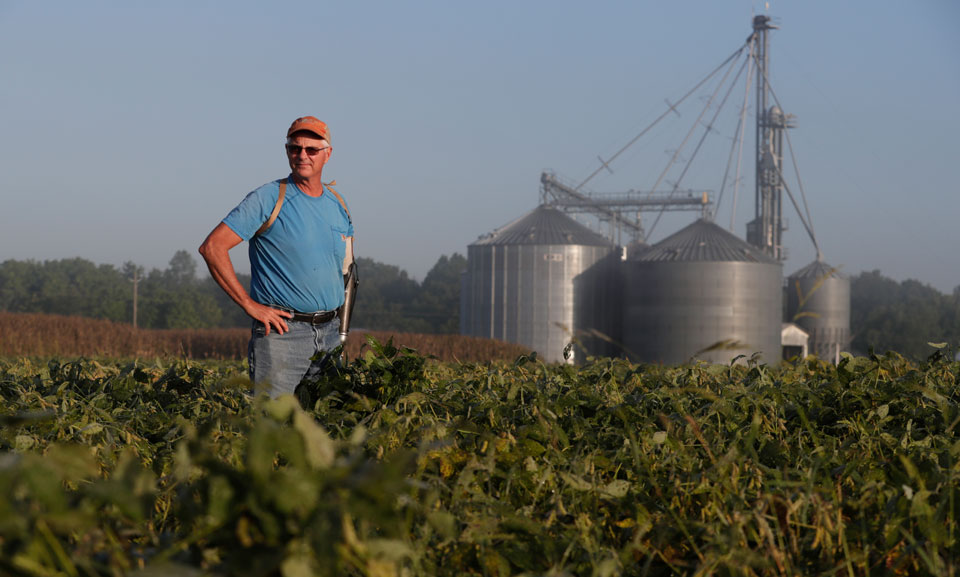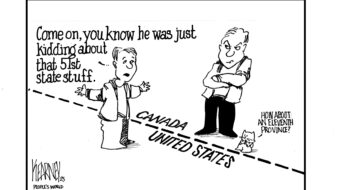
SOMEWHERE IN AMERICA’S HEARTLAND — It has been a violent spring for residents of Tornado alley—the popular name for parts of the Midwest, moving up all the way to the Canadian prairies, prone to extreme weather patterns.
The second half of May alone saw at least 245 tornadoes ravage the Midwest, Plains, and Atlantic regions. Excessive rainfall, in line with the effects of our climate crisis, has caused never before seen levels of flooding, drowning cities and rural communities.
As we enter June, American farmers are still unable to plant this year’s crop; there’re never enough dry days for them to go to work. The National Weather Service places blame on a “stubborn jet stream over the plains and Ohio Valley.”
Of course, the weather isn’t the only thing to blame for the financial and crop depression in America’s agricultural heartland. There’s another “stubborn jet stream” full of hot air and misguided policies coming from the Eastern seaboard: President Donald J. Trump.
Trump’s tiff with China over trade, the “easy to win trade war,” continues to hurt farmers and rural areas. American farm income has dropped 16 percent since last year. Soybean farmers are still getting hit the hardest, but the pain and suffering are spreading fast—Chicago corn went down 1.9 percent to $3.87 a bushel.
So, what is Donald Trump, who will certainly need farmers’ votes to get re-elected, going to do?
Bail them out with federal funds.
It’s a “Hail Mary” throw by the White House, as Trump’s support in the farmlands has plunged to levels not seen since October 2016. Purdue University and CME Group’s agricultural sentiment index fell by 14 points to 101 in May from 115 in April, “effectively erasing all of the large improvement in farmer sentiment that took place following the November 2016 election.”
“The farmers have been attacked by China,” said Trump at a May 23 press conference unveiling the agricultural aid package. “But the $16 billion of funds will…make clear that no country has veto on America’s economic and national security.”
Officials with the U.S. Department of Agriculture said the $14.5 billion in direct payments would roll out in three separate batches beginning in late July. The final payment is scheduled for early 2020—election year.
“The package we are announcing today ensures that farmers will not bear the brunt of those trade practices by China or any other nations,” Secretary of Agriculture Sonny Perdue said. “While farmers would tell you they’d rather have trade, not aid, without the trade … they’re going to need some support.”
Ah, but there’s a catch to this multi-billion bailout bonanza.
It won’t be the hard working, sun-stained, rugged Mom and Pop farmers—the ones Trump likes to parade at campaign rallies like show-ponies—who’ll be collecting the most from the bailout. It will be rich farmers and big agribusinesses.
An initial analysis of the first agriculture bailout program conducted last year by the Environmental Working Group found huge amounts were dispersed to farms with enough acreage to have collected eight-figure subsidies from 1995-2017—amounts in the tens of millions of dollars each. The findings show a pattern and suggest “the biggest payments will go to the wealthiest farmers, who need them the least,” said EWG analyst Anne Scheringer.
In fact, the Trump administration’s focus is so slanted towards big business interests that it almost gave away a huge stack of cash to a foreign-owned multinational. It would have been a public relations disaster for this China-bashing president if a planned $240,000 subsidy had been disbursed to pork giant Smithfield Foods—a Chinese-owned company.
Is it really a surprise though that Trump is deliberately lying about the character and type of farmers he’s dedicated to helping?
“Our great Patriot Farmers will be one of the biggest beneficiaries of what is happening now,” Trump tweeted May 14. “The Farmers have been ‘forgotten’ for many years. Their time is now!”
Recent People’s World coverage of Trump’s trade war:
U.S./China Trade War: The fight to save America’s farmland
As noted earlier, the truth is simple: Farmers would choose normal trade over government subsidies.
“Ultimately, this package is only a short-term fix for a very long-term problem. Farmers rely on markets to make a living,” National Farmers Union President Roger Johnson said in a May 23 statement. “Our ongoing trade wars have destroyed our reputation as a reliable supplier and have left family farmers with swelling grain stores and empty pockets. The very least we can do is provide our country’s struggling food producers with the certainty of a longer-term plan that also addresses the persistent and pernicious problem of oversupply.”
Breaking down the emergency agriculture subsidy
According to Perdue, Trump’s agriculture secretary, this year’s aid package is a redesign of last year’s program, supposedly based on industry feedback.
The new package will have a single payment rate per county, calculated by the damages in the area, instead of a rate for each farm product affected across the nation.
Payments will be made in up to three tranches, with the second and third evaluated as market conditions and trade opportunities dictate. The first tranche will begin this summer in late July/early August as soon as practicable after Farm Service Agency crop reporting is completed by mid-July. If conditions warrant, the second and third tranches will be made in November and early January.

There will be a $1.4 billion Food Purchase and Distribution Program (FPDP) through the Agricultural Marketing Service (AMS) to purchase surplus commodities (unsold farm goods) affected by trade retaliation. This would include fruits, vegetables, some processed foods, beef, pork, lamb, poultry, and milk. The items would then be distributed by the Food and Nutrition Service (FNS) to food banks, schools, and other outlets serving low-income individuals.
Some $100 million would be spent through the Agricultural Trade Promotion Program (ATP) to assist in developing new export markets on behalf of producers—sending U.S. crops to nations struggling economically.
The redesign of the payment and surplus crop arrangements has led many farmers to debate whether it would impact individual planting decisions. Some agricultural analysts have said the package could encourage farmers to try and seed their crops in order to qualify for relief, even when they know a successful harvest will be next to impossible.
And, there’s the other worry, the political one: That the payments will only go to counties that overwhelmingly voted for and supported Trump.
Corn and soybean farmer Dan Henebry from Buffalo, Illinois, said he wants Trump to end the trade war with China and worries payments are directed to Trump-base rural areas.
“If we solve the issue, we wouldn’t need this,” he said about the aid package.
And he’s absolutely right, the American people do not need this. And it’s a shame we must now brace for further fallout from Trump’s tariff rampage through Mexico.
We can rest assured the counter-tariffs from China, Mexico, or any other countries targeted by the president will be swift and target pro-Trump states.










